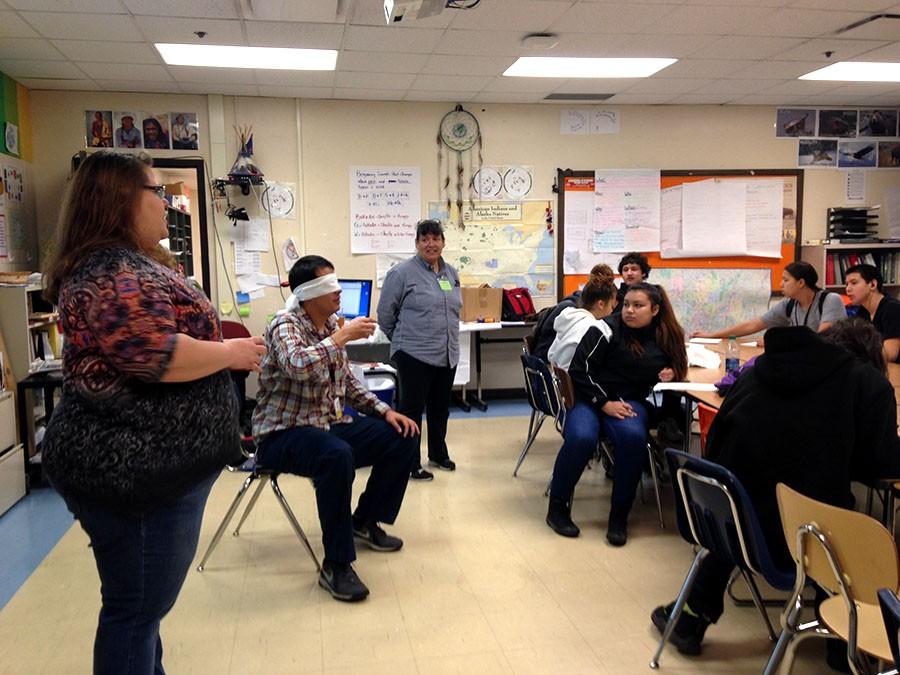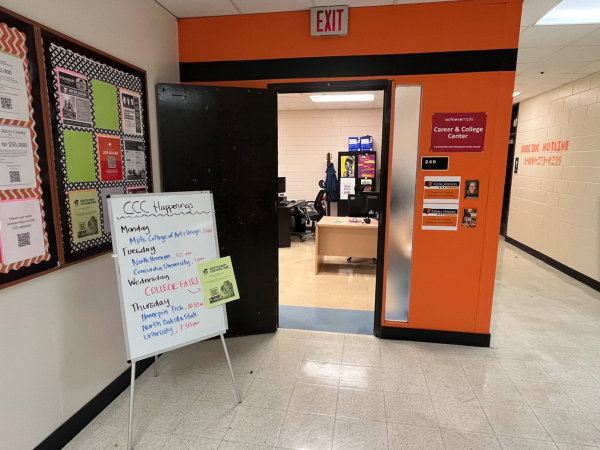White history occupies too much of South classes
First hour All Nations culture seminar class participates in a science experiment to identify skittle flavors while blind folded. Vincent Patton All Nations history teacher is the first to participate as students Rosa Lefthand, Jeff Laroque, JJ Downwind, Lewis Ruvulcaea, Ladayah Jackson and staff member Teti Greyowl look on.
November 19, 2015
In the recent school year, South has made strides to add classes for different racial and cultural groups to try and accommodate a diverse student body but only as electives. The basic requirements for student’s history classes, however, show minimal variations in perspectives and narratives. As such, mostly white culture is covered in required history courses at South.
Given that people of color’s (P.O.C.) cultures are chosen electives, one questions if they are not important enough to learn about in history. South has a large diverse student body, whose cultures could not possibly be taught by only the main history courses.
South prides itself on being ethnically diverse and rich in culture but the lessons do not reflect that. This could be a slippery slope. “A lot of where racism and inequality first start is where you learn it, your parents, the people around you,” commented Ethan Cherne, a sophomore student .
All Nations history teacher Vincent Patton runs his classes differently from the rest of South. “It is key for my students in the All Nations program in that if they do not learn their cultural ways, that they get a little lost in this big old building that is South,” mentioned Patton.
“I have planned at least one cultural event per day. That could be lacrosse, that could be sports, that could be games, that could be as simple as food or eating different things. Minimally, I will probably include some Ojibwe and Lakota language in my classroom every day,” explained Patton.
While South is only four years of a student’s life, the issue of being culturally aware will graduate to the adult world with students. Unlike in predominantly white suburban high schools, South students have an opportunity to learn about P.O.C.’s cultures.
Patton and Cherne agree on the importance of this opportunity. “I have had that problem. I was at Field which is a generally white school, 90% of the kids probably, and it’s really different from here where your head’s in the water when you are talking about it [culture and the issues that come with it],” inserted Cherne.
Patton has a similar idea. “You get to see it from South High compared to a suburban white school that it’s vastly different, that we wouldn’t have nearly as much interaction or learning about different people,” he stated.
Cherne muses with the idea that culture has a broad and simple definition, one that could be applied to any group of people with something in common. “Culture is how people act around each other, it is a community, it’s a collaborative activity that everybody has to be in,” Cherne asserted.
As a result of not including cultural diversity in the curriculums here, students are forced to take time out of their day to explain to their peers what their culture is, in an alienating fashion. In worst cases, students are caused emotional distress and anger.
South student Navashree Ramnarine feels cultural education is crucial. “It [knowledge of other cultures] helps you to know everything that you don’t know about that culture,” she said. Ramnarine culture was disrespected by other people at South and said that she feels “mad and mad [again].”
Speaking against this disrespect of culture requires courage. Although, Ramnarine says that she has no problem correcting others. “I am more vocal, if they say something bad I would argue back with them about it,” she says.
Ramnarine thinks of her culture simply as unity. “First, they ask what is it about, and the first thing, it’s about togetherness everyone has to come together and join and engage in activities,” she described.
Student Bola Ogunlana views her culture as a big part of her life. It’s present in what she eats and sometimes how she dresses. “My culture is mixed African culture and American culture,” she said. “I haven’t seen any curriculum on my culture,” she stated.
She describes only one assignment in her English class about her culture but no others. Ogunlala explains that one consequence to having such little representation is people making false assumptions about her. “People assume that since I’m African, I speak some type of [language] where you click your tongue,” she said.
Ogunlala has had to explain her culture to others and recalls that people would continue to argue with her even after she made a clarification. “It makes me mad that people think that they know better than me even though I have experienced this culture and they haven’t,” she expressed.
Patton notices a similar situation about his students and their cultures. “Specifically one of the things that my students face is when ever we smudge down with the traditional sage, that many students would think that it smells like marijuana again, it might have a little smell, but it’s not quite that marijuana smell. If someone might assume it [the students] take offense, like hey, this is the way we have done it forever, that now people are negatively associating it,” he explained.
In an article by the Huffington Post, the author, Mathew Lynch asserts that promoting cultural diversity can help students respect different cultures.“If students are taught about the contributions that people of various ethnicities, genders, and creeds have made to a variety of different artistic, scientific, and political fields then they’re more likely to respect and value diverse cultural backgrounds as a whole,” states Lynch.
This practice would not only allow students to respect cultures that they are not members of, but it would provide positive role models for students of color to look up to. Patton goes beyond teaching role models and contributions to his students. “Historical figures are a key thing to learn and contributions are also key but, that just the surface level. Once you get deeper after the students have that established, yes contributions are great, but what about the problems these people overcame, what kind of fighting did they have with in themselves, then you get that better understanding of that whole individual,” he conveys.
Lynch adds that using culturally diverse curriculums can be beneficial in the long run. “A primary goal of culturally responsive education is to help all students become respectful of the multitudes of cultures and people that they’ll interact with.” The article continues by noting that posting signs in multiple languages and planning lessons centered around multiple cultures is key in this practice and normalizing seemingly distant cultures.
Patton recognizes that students also need the time to practice their own cultures. As a result, every morning during first hour he gives his students time to interact with them. “I teach A.P U.S. history, 9th grade history, and then I also got this first hour seminar class which is, we like to call it the culture class, that gives our students the opportunity to practice their culture for one hour, everyday,” described Patton.
Hopefully, other programs will follow the All Nations program’s lead and begin to implement time in the day for students to learn about and interact with their cultures. Maybe then, students of color will begin to feel more comfortable talking about their cultures in school.












